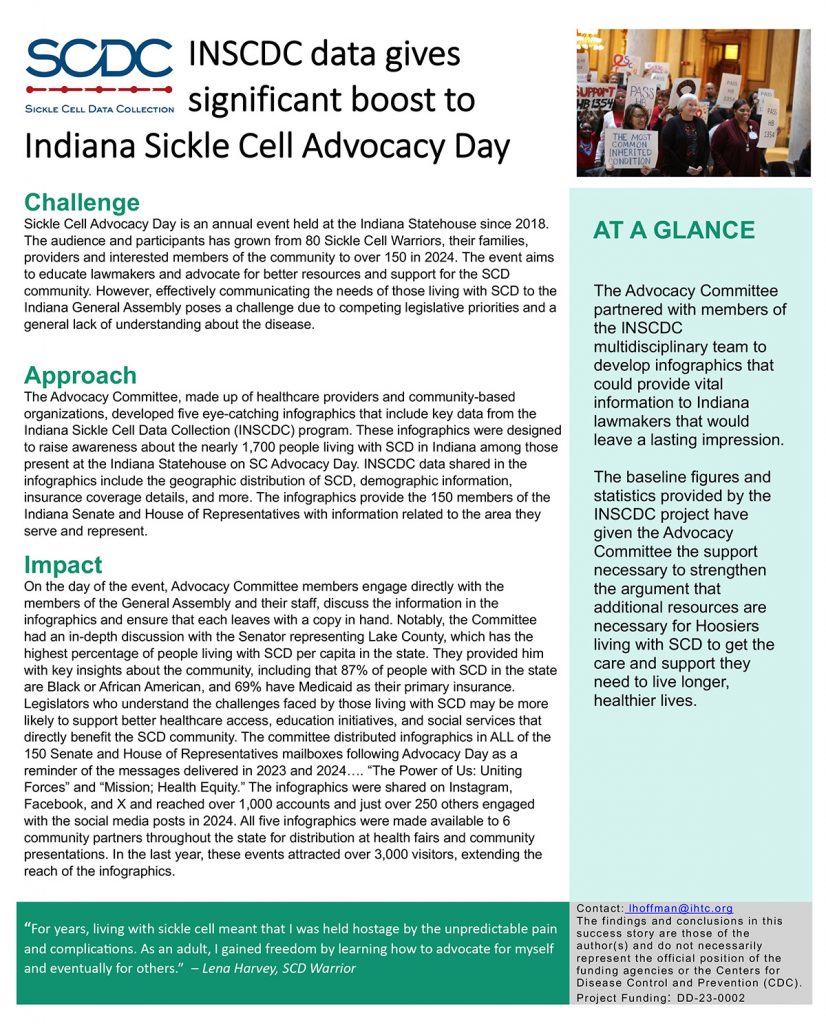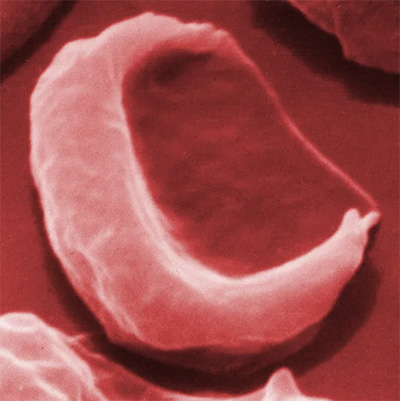Sickle cell disease (SCD) is a group of inherited disorders in which red blood cells become hard and sticky and look like a C-shaped farm tool called a “sickle.” While people with SCD can live full lives and enjoy activities that people without SCD do, individuals with SCD often feel unwell and need medical care, and SCD can cause early mortality.
Despite the importance of identifying SCD patients to ensure they receive appropriate care, surveillance related to SCD is challenging for public health agencies. To improve surveillance, Regenstrief, the Indiana Hemophilia & Thrombosis Center and other clinical sites contribute data to the Indiana Department of Health (IDOH). In addition to surveillance, IDOH creates and shares a deidentified (anonymous) dataset that can be used by Regenstrief for purposes like the dashboard below.

Our Partners
This program was developed with grant funding (DD23-0002) from the U.S. Centers for Disease Control to longitudinally surveil Sickle Cell Disease in Indiana, with a goal of maintaining a registry that provides timely and locally relevant information to inform local public health programs and policy development. The principal investigators are Dr. Brandon Hardesty (Indiana Hemophilia and Thrombosis Center) and Chinedum Ojinnaka, PhD, MPH, MBBS, (IU Fairbanks School of Public Health). Dr. Brian Dixon (Regenstrief Institute) is a co-investigator.

Indiana Hemophilia and Thrombosis Center (IHTC) is the primary receiption of this grant funding. IHTC cares for people with sickle cell disease (SCD) as well as other bleeding and clotting disorders. Besides providing healthcare, IHTC works with three community-based organizations that support Indiana residents of all ages with SCD.
- The SAFE Program (Screening, Assessment, Follow-up, and Education) covers infants with SCD or sickle cell trait from birth to age 1. Families receive education, care coordination, and help with resources.
- The SCORE Program (Sickle Care Coordination, Outreach, and Education) helps people with SCD ages 1-21 get the care they need.
- The CASCADE (Community Access for Sickle Cell ADult caRE) Program helps adults (21+) with SCD find local support to improve their health and quality of life.
Data Success Stories


Background
Sickle Cell Disease (SCD), the most common monogenic disorder in the United States, refers to a collection of inherited red blood cell disorders that affect an estimated 100,000 people in the United States. Prior published estimates suggested that approximately 1,200 individuals live with SCD in Indiana. In 2023, the Indiana Sickle Cell Data Collection (INSCDC) program found that nearly 1,700 people with SCD reside in Indiana. Additionally, Indiana’s newborn screening program (NBS) identifies approximately 35 infants with SCD each year.
SCD has a profound effect on quality of life. Adults with SCD score significantly worse on quality-of-life scales than the general U.S. population, reflecting the complexity of this disorder and its effects on the multiple facets of an individual’s life. Although universal newborn screening (NBS) and preventative treatments effectively eliminated early childhood mortality in the U.S., patients with SCD continue to experience increased morbidity and premature mortality.
In 2019, the IN SCDC, participated in the CDC’s SCD surveillance capacity building program. This program established a framework for collaboration and alignment of governance among multiple stakeholders to enable improved understanding of the SCD burden and improvement of SCD care in Indiana. In 2020, IN SCDC received a 3-year grant from the CDC to collect, analyze, and disseminate aggregate SCD data as part of the Sickle Cell Data Collection program. After receiving the 3-year grant, IN SCDC created a multidisciplinary team, collected, and reported SCD data from 2015-2020, created a fact sheet of SCD data for Indiana, published a manuscript on the methodology of the data collection, co-authored a manuscript on SCDC working with community-based organizations and members of other SCDC sites, and are currently working on creating an online dashboard to disseminate data to the public.
The IN SCDC aims to expand and strengthen a multiple-source, longitudinal surveillance system for individuals with SCD in Indiana and contribute to a nationwide SCD surveillance database. At a state level, these data will promote targeted education campaigns, describe pertinent social determinants of health, and identify gaps in care to drive policy change and allocate resources for this underserved community. This proposal describes how IN SCDC will collect, analyze, and distribute data across multiple sectors, develop new partnerships, provide mentorship, and inform policies supporting the SCD community to address health disparities, social determinants of health, and barriers to care to improve quality of life for persons with SCD.
Cohort Definition
This cohort includes individuals from the Indiana Network for Patient Care (INPC) with a diagnosis of Sickle Cell Disease between January 1, 2015 and December 31, 2023 (incremental refreshes will be done on a annual basis).
Criteria SCD diagnoses:
ICD 9 Codes
- 282.6 – Sickle Cell Disease unspecified
- 282.61 – Hb-SS without crisis
- 282.62 – Hb-SS with crisis
- 282.63 – Sickle Cell/Hb-C disease without crisis
- 282.64 – Sickle Cell/Hb-C disease with crisis
- 282.68 – Other Sickle-Cell disease without crisis
- 282.69 – Other Sickle-Cell disease with crisis
- 517.3 – Acute Chest Syndrome
- 289.52 – Splenic sequesation
- 282.41 – Sickle-cell thalassemia without crisis
- 282.42 – Sickle-cell thalassemia with crisis
- 282.4 – Sickle-cell thalassemia
ICD 10 Codes:
- D57.0 – Hb-SS disease with crisis
- D57.00 – Hb-SS disease with crisis unspecified
- D57.01 – Hb-SS disease with acute chest syndrome
- D57.02 – Hb-SS disease with splenic sequesation
- D57.1 – Sickle-cell disease without crisis
- D57.2 – Sickle-cell/Hb-C disease
- D57.20 – Sickle-cell/Hb-C disease without crisis
- D57.21 – Sickle-cell/Hb-C disease with crisis
- D57.211 – Sickle-cell/Hb-C disease with acute chest syndrome
- D57.212 – Sickle-cell/Hb-C disease with splenic sequesation
- D57.219 – Sickle-cell/Hb-C disease with crisis unspecified
- D57.4 – Sickle-cell thalassemia
- D57.40 – Sickle-cell thalassemia without crisis
- D57.41 – Sickle-cell thalassemia with crisis
- D57.411 – Sickle-cell thalassemia with acute chest syndrome
- D57.412 – Sickle-cell thalassemia with splenic sequesation
- D57.419 – Sickle-cell thalassemia with crisis unspecified
- D57.8 – Other sickle-cell disorders
- D57.80 – Other sickle-cell disorders without crisis
- D57.81 – Other sickle-cell disorders with crisis
- D57.811 – Other sickle-cell disorders with acute chect syndrome
- D57.812 – Other sickle-cell disorders with splenic sequesation
- D57.189 – Other sickle-cell disorders with crisis unspecified
Data Source Descriptions
Data from four clinical and administrative sources across Indiana — including the state’s Medicaid program, the Indiana Health Information Exchange, the Indiana Hemophilia and Thrombosis Center, and the Indiana Department of Health — are linked and integrated to create a cohort of Indiana SCD patients. The counts presented are the absolute number of SCD patients in each category. The rates are the number of cases per 100,000 citizens (via the Census) of that County.
The data for these dashboards and download files is derived from the INPC. While it is a comprehensive data set representing a large portion of the State, it does not cover all of Indiana. Accordingly, there may be discrepancies between State data and INPC-derived data. Additionally, the data sets may be subject issues related to data acquisition. For more detail on INPC, please visit: https://www.regenstrief.org/rds/data/#sources.





